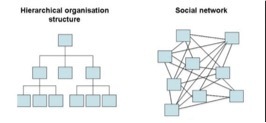I just finished reading the book The Starfish and the Spider, by Ori Brafman and Rod A. Beckstrom, which was published in 2006. I was turned on to the book by a friend who expressed amazement of the history and structure of an organization called iEARN (International Education and Resource Network). Twenty-eight years old, with 140 countries, and over 2 million students and educators who have collaborated on-line, and 1,000s interacting daily interacting daily--the world's largest K-12 educational network, iEARN functions without a headquarters, a center, through the power of virtual exchange. Virtual exchange programming is meaningful, technology-enabled, sustained, people to people education. The book describes the benefits of such a structure, citing examples of Craig's List, Napster and other technology-based organizations that lack a centrally controlling body. The subtitle of the book is "The Unstoppable Power of Leaderless Organizations."
I had a feeling of deja vu when reading a book, written in 2006, that discovers a revolutionary new organizational structural model, when iEARN had been created 18 years earlier with that same "new" structure. Ironically, I highlighted the decentralized iEARN structure as one of the factors in its longevity in an article in EdTech Digest in September 201 and will do so again when I publish my history of iEARN.
But, let's get back to the starfish and the spider. If you have not read the book (and I hope you do), the analogy that Brafman and Beckstrom make is that a spider has legs, but more  importantly, a head without which it will die. On the other hand, a starfish has legs, but no head. Cutting off a leg results in a new leg, and at the same time a new starfish emerges from the cut-off portion of the leg. Each leg has the elements of a whole starfish and can live without the other members. The authors cite the benefits of such a decentralized structure--without a head/brain/headquarters--for quick and flexible adaptation, as well as for independent communications and functioning among the different parts of the organization, without having to go to the center for approval and control.
importantly, a head without which it will die. On the other hand, a starfish has legs, but no head. Cutting off a leg results in a new leg, and at the same time a new starfish emerges from the cut-off portion of the leg. Each leg has the elements of a whole starfish and can live without the other members. The authors cite the benefits of such a decentralized structure--without a head/brain/headquarters--for quick and flexible adaptation, as well as for independent communications and functioning among the different parts of the organization, without having to go to the center for approval and control.
The authors ask a number of questions to determine if an organization is functioning like a starfish:
1) Is there a person in charge?
2) Are there headquarters?
3) If you thump it on the head, will it die?
4) Is the organization flexible or rigid?
5) Can you count the employees or participants?
6) Are working groups funded by the organization or are they self-funding?
7) Do working groups communicate directly or through intermediaries?
Persons involved with iEARN anywhere in the world will know the answers to most of these questions immediately. And, in fact, most will give the questioner a quizzical look as if to ask why are you asking such a silly question? Reflecting what the authors describe as a "leaderless organization," iEARN was initially created with an International Secretariat in New York City, but jettisoned that model in 1998 for a network that ran by itself and its participants. It eliminated the International Secretariat and 18 years later has no international office or "person in charge."
The organization encourages interaction and joint decision-making by its financially autonomous Country Coordinators in 140 countries and estimates the number of participants each day to be in the range of several million, but has no real way of knowing the exact number. Countries have come and gone, but the life of the network does not depend on any one country to survive and thrive. Any can be thumped on the head (and often is due to global, financial difficulties, government policies, natural disasters or changes in technology), but survival is not in question.
I once overheard a conversation in which the former head of the "Center for Children and  Technology (CCT)" in New York City, speaking admirably of the goals and mission of iEARN in 1996-eight years after it was launched. She was commenting highly on these goals, but was equally adamant that it would not survive beyond the initial founders and participating schools because such do-gooder initiatives do not last and cannot scale. Although we had no empirical evidence to suggest otherwise, it led me to eventually examine the reasons for its ultimate dramatic expansion, acceptance, and longevity and sustainability. My examination ended up in the animal world.
Technology (CCT)" in New York City, speaking admirably of the goals and mission of iEARN in 1996-eight years after it was launched. She was commenting highly on these goals, but was equally adamant that it would not survive beyond the initial founders and participating schools because such do-gooder initiatives do not last and cannot scale. Although we had no empirical evidence to suggest otherwise, it led me to eventually examine the reasons for its ultimate dramatic expansion, acceptance, and longevity and sustainability. My examination ended up in the animal world.
So, thanks to Brafman and Beckstrom, I now know that iEARN is the world's largest K-12 online educational network, in part because it is a stellar starfish.